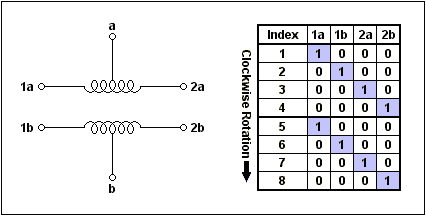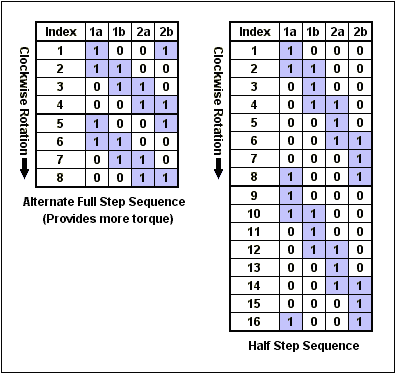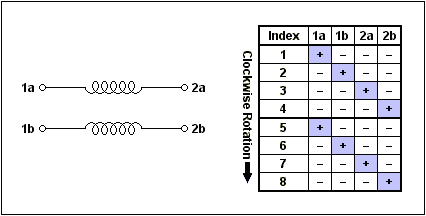

Design Center
STEPPER MOTORS
The details below are not basic details, but intermediate.
Unipolar Stepper Motor
Unipolar stepping motors, will have 5 or 6 wires, with a center tap on each of two windings. In use, the center taps of the windings are typically wired to the positive supply, and the two ends of each winding are alternately grounded to reverse the direction of the field provided by that winding.

Normal stepping
To rotate the motor continuously, apply power to the two windings in sequence. Assuming positive logic, where a 1 means turning on the current through a motor winding, the following two control sequences will spin the motor clockwise:
Winding 1a 1000100010001000100010001
Winding 1b 0100010001000100010001000
Winding 2a 0010001000100010001000100
Winding 2b 0001000100010001000100010
time --->
This sequences shown above will rotate a permanent magnet one step at a time. This sequence only powers one winding at a time, thus it uses less power.
Full Step & Half Step Sequences:
To rotate the motor continuously, apply power to the two windings in sequence. Assuming positive logic, where a 1 means turning on the current through a motor winding, the following two control sequences will spin the motor clockwise:
Winding 1a 1000100010001000100010001
Winding 1b 0100010001000100010001000
Winding 2a 0010001000100010001000100
Winding 2b 0001000100010001000100010
time --->
This sequences shown above will rotate a permanent magnet one step at a time. This sequence only powers one winding at a time, thus it uses less power.
Full Step & Half Step Sequences:

Power Stepping
Winding 1a 1100110011001100110011001
Winding 2a 0011001100110011001100110
Winding 1b 0110011001100110011001100
Winding 2b 1001100110011001100110011
time --->
This sequences shown above will rotate a permanent magnet one step at a time. This sequence involves powering two windings at a time and generally produces a torque about 1.4 times greater than the normal stepping sequence while using twice as much power.
Half Stepping
Note that the two halves of each winding in normal and power stepping are never energized at the same time. The step positions produced by the two sequences above are not the same; as a result, combining the two sequences allows half stepping, with the motor stopping alternately at the positions indicated by one or the other sequence. The combined sequence is as follows:
Winding 1a 11000001110000011100000111
Winding 2a 00011100000111000001110000
Winding 1b 01110000011100000111000001
Winding 2b 00000111000001110000011100
time --->
Driver circiuts for UNIPOLAR stepper motors:
Winding 1a 1100110011001100110011001
Winding 2a 0011001100110011001100110
Winding 1b 0110011001100110011001100
Winding 2b 1001100110011001100110011
time --->
This sequences shown above will rotate a permanent magnet one step at a time. This sequence involves powering two windings at a time and generally produces a torque about 1.4 times greater than the normal stepping sequence while using twice as much power.
Half Stepping
Note that the two halves of each winding in normal and power stepping are never energized at the same time. The step positions produced by the two sequences above are not the same; as a result, combining the two sequences allows half stepping, with the motor stopping alternately at the positions indicated by one or the other sequence. The combined sequence is as follows:
Winding 1a 11000001110000011100000111
Winding 2a 00011100000111000001110000
Winding 1b 01110000011100000111000001
Winding 2b 00000111000001110000011100
time --->
Driver circiuts for UNIPOLAR stepper motors:
Driver circuit :1

For small low-current motors (below a few hundred milliamps per winding), consider using the Signetics ULN2003 chip. This eliminates the need for the darlington transistor, and can be directly driven by TTL or CMOS logic.
Driver circuit :2
This circuit, duplicated once per winding, will generally suffice to control even a fairly large unipolar stepping motor.

Bipolar Stepper Motor:

Bipolar permanent magnet motors are constructed with exactly the same mechanism as is used on unipolar motors, but the two windings are wired more simply, with no center taps. Thus, the motor itself is simpler but the drive circuitry needed to reverse the polarity of each pair of motor poles is more complex.
Terminal 1a + - - - + - - - + - - - + - - - + + - - + + - - + + - - + + - -
Terminal 2a - - + - - - + - - - + - - - + - - - + + - - + + - - + + - - + +
Terminal 1b - + - - - + - - - + - - - + - - - + + - - + + - - + + - - + + -
Terminal 2b - - - + - - - + - - - + - - - + + - - + + - - + + - - + + - - +
time - - - >
Note that these sequences are identical to those for a unipolar permanent magnet motor, at an abstract level, and that above the level of the H-bridge power switching electronics, the control systems for the two types of motor can be identical.
- 1a ---/\/\/\--- 2a
1b ---/\/\/\--- 2b
Terminal 1a + - - - + - - - + - - - + - - - + + - - + + - - + + - - + + - -
Terminal 2a - - + - - - + - - - + - - - + - - - + + - - + + - - + + - - + +
Terminal 1b - + - - - + - - - + - - - + - - - + + - - + + - - + + - - + + -
Terminal 2b - - - + - - - + - - - + - - - + + - - + + - - + + - - + + - - +
time - - - >
Note that these sequences are identical to those for a unipolar permanent magnet motor, at an abstract level, and that above the level of the H-bridge power switching electronics, the control systems for the two types of motor can be identical.
USEFUL TIP
Distinguishing the wiring of motors using multimeter
To distinguish a bipolar permanent magnet motor from other 4 wire motors, measure the resistances between the different terminals. It is worth noting that some permanent magnet stepping motors have 4 independent windings, organized as two sets of two. Within each set, if the two windings are wired in series, the result can be used as a high voltage bipolar motor. If they are wired in parallel, the result can be used as a low voltage bipolar motor. If they are wired in series with a center tap, the result can be used as a low voltage unipolar motor.
To distinguish a bipolar permanent magnet motor from other 4 wire motors, measure the resistances between the different terminals. It is worth noting that some permanent magnet stepping motors have 4 independent windings, organized as two sets of two. Within each set, if the two windings are wired in series, the result can be used as a high voltage bipolar motor. If they are wired in parallel, the result can be used as a low voltage bipolar motor. If they are wired in series with a center tap, the result can be used as a low voltage unipolar motor.
www.ewizlab.com